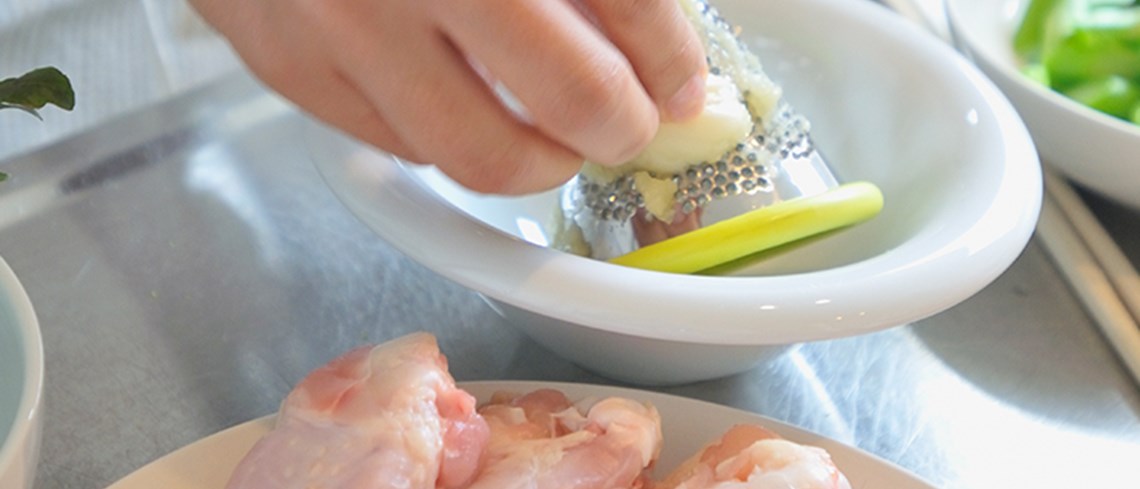Food poisoning (foodborne illness)
Food poisoning (foodborne illness) happens when we eat food that has been contaminated – usually by germs, bacteria, or a virus. It can be unpleasant, but it rarely needs medical treatment, and you should return to full health in a day or two.
In most cases, the food is contaminated by bacteria or viruses like:
- Campylobacter
- Salmonella
- Escherichia coli (E. coli)
- Norovirus
Raw foods, including meat, poultry, eggs, fish and seafood, raw fruit, and vegetables, can often contain high levels of germs that easily spread to other foods and surfaces around the kitchen on unwashed hands and via surface contamination (e.g., chopping boards, cooking utensil, taps).
Cross-contamination between surfaces contributes to nearly 40% of all food-borne illnesses. For these reasons, we must take extra care when handling or preparing food in the kitchen and define clear food hygiene rules to live by for the rest of our lives.
Why is food poisoning an important issue?
While most food poisoning cases don’t need medical attention, some rarely do. The most common serious problem caused by food poisoning is dehydration.
As long as you drink a sufficient amount of fluids to replenish what you've lost due to vomiting or diarrhea, it's unlikely that you'll become dehydrated when you're in good health.
Even though food poisoning is a common disease, many people aren’t aware of it. Therefore, this article discusses food poisoning symptoms, types, causes, treatment, and prevention.
Common causes of food poisoning
Campylobacter, Salmonella, Listeria, Escherichia coli (E. coli), and Norovirus (winter vomiting virus) are the prime culprits for food poisoning.
Here are some of the most common causes:
- Eating raw or undercooked food (especially poultry, pork, burgers, sausages and kebabs)
- Food that is ‘out of date or has not been refrigerated correctly
- Eating food that someone with diarrhea or vomiting has handled
- Cross-contamination (where germs from a portion of contaminated food are spread to other foods)
Types of food poisoning
Understanding the different types of food poisoning is important for identifying the source of illness and implementing appropriate treatment and prevention measures.
Here are some common types of food poisoning:
Bacterial food poisoning
Salmonella
Salmonella bacteria often contribute to cases of foodborne illness, with symptoms typically emerging within a timeframe ranging from 6 hours to 6 days after exposure.
Common symptoms include diarrhea, fever, and abdominal cramps. This pathogen is mostly found in poultry, eggs, dairy products, fruits, vegetables, meat, poultry, nuts, nut products, and spices.
Escherichia coli (E. coli)
Some certain Escherichia coli (E. coli) bacteria can lead to severe illness, characterized by symptoms like bloody diarrhea, abdominal cramps, and kidney damage, typically emerging within a timeframe ranging from 2 to 10 days after exposure.
This pathogen is mostly found in raw or undercooked meat, unpasteurized milk or juice, soft cheeses from unpasteurized milk, and fresh fruits and vegetables.
Campylobacter
Campylobacter (bacterium) food poisoning often results in fever, nausea, abdominal cramps, and diarrhea (sometimes bloody), typically emerging within a timeframe ranging from 2 to 5 days after exposure. It is commonly associated with undercooked poultry, shellfish, unpasteurized milk, and contaminated water.
Food poisoning symptoms
Depending on the type of germ involved, symptoms may begin from one to 36 hours after eating contaminated food.
You may experience one or more of the following:
- Nausea
- Vomiting
- Diarrhea
- Other symptoms may include:
- Stomach cramps
- Abdominal pain
- Loss of appetite
- High temperature
- Muscle pain
- Chills
Prevention and safe food handling
The best way to prevent food poisoning is to abide by food safety and hygiene rules and avoid any food that may be unsafe.
Here’s how to prevent food poisoning:
Hand washing:
Frequently wash your hands with antibacterial soap or liquid hand wash for at least 20 seconds. Do this, especially after using the toilet, eating or drinking, and before and after handling food.
You must also remember the 7 steps for the most effective hand-washing experience to ensure you and your loved ones are always safe from food poisoning.
Wash fruits and vegetables:
Always thoroughly rinse fruits and vegetables under running water before eating, peeling, or preparing.
Clean and disinfect utensils and surfaces:
Clean and disinfect food preparation tools and surfaces using disinfectant spray or multiuse wipes for surfaces and liquid, powder, or soap detergent combined with hot water for utensils, cutlery, and dishes.
Cook food thoroughly
Cook food thoroughly at their required cooking temperature, especially meat or fish. Cook meat and fish to at least 145 F (63 C) and poultry to at least 165 F (74 C). Ensure reheated food is piping hot throughout, and never reheat it more than once.
Refrigerate or free leftovers
Cool, cover, and refrigerate leftover cooked food separately in large portions in smaller containers within one hour. You can keep the leftovers for 3 to 4 days in the refrigerator. If you don't think you'll eat them within four days, freeze them immediately.
FAQs
How long does food poisoning last?
The most common types of food poisoning last around 12 to 48 hours. You must focus to ensure that your body gets enough fluids so you don’t become dehydrated.
Will food poisoning go away on its own?
In most cases, people with food poisoning get better without medical treatment. However, some cases require fluid replacement and over-the-counter medicines to help relieve your symptoms.
Can food poisoning be contagious?
Yes, some types of food poisoning, such as Norovirus and Salmonella, can spread from person to person through contaminated surfaces or close contact.
